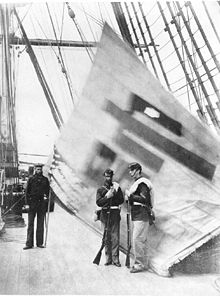|
Sujagi
The Sujagi is a flag with the hanja 帥, pronounced su in Korean, that denotes a commanding general. The whole term literally means, "Commanding general flag". Only one sujagi is known to exist in Korea. The color is a faded yellowish-brown background with a black character in its center. It is made of hemp cloth and measures approximately 4.15m x 4.35m.[1]   HistoryThis type of flag was put in a fortress where a commanding general was located.[2] In the case of the extant sujagi in Korea, it represented General Eo Jae-yeon who, in 1871, commanded the Korean military forces on Ganghwa Island, which is off the northwest coast of present-day South Korea, near the capital of Seoul. It was captured by the United States Asiatic Squadron in June of that year during the United States' expedition to Korea.[3] As with other war prizes, it was put into the collection of the museum at the United States Naval Academy in Annapolis, Maryland.[4] In October 2007, after many years of petitions by South Korea to the United States government, the flag was returned to South Korea on a long-term, ten-year loan.[5][6] After being returned, it was displayed at the National Palace Museum of Korea in Seoul until 2009, when it was moved to the Ganghwa History Museum on Ganghwa Island.[7] As of September 2022, the lease had been renewed for the flag to stay in South Korea until at least October 2023.[8] References
Notes
See alsoExternal links |
||||||||||||||
Portal di Ensiklopedia Dunia
